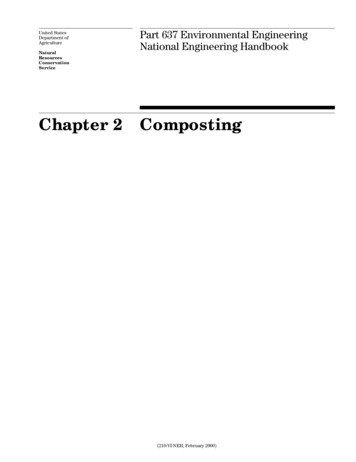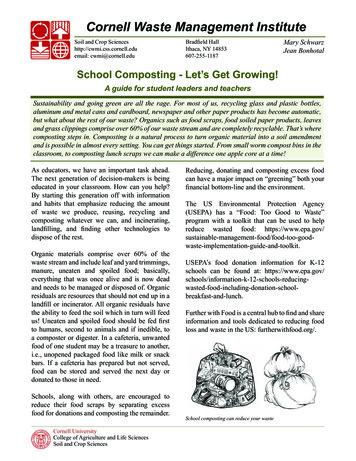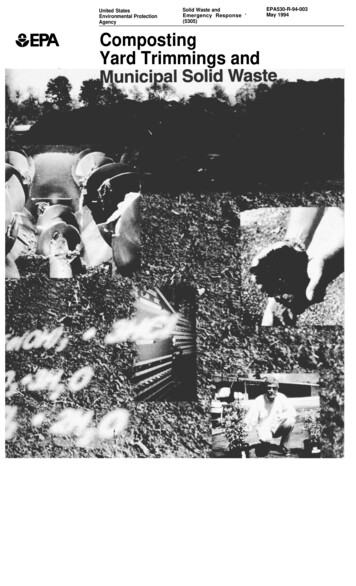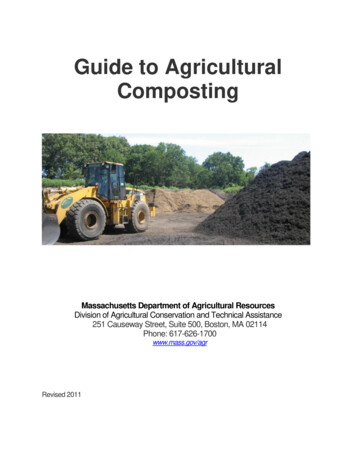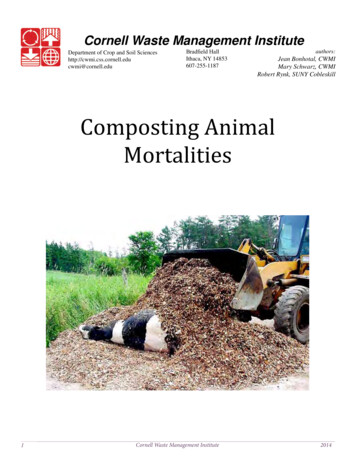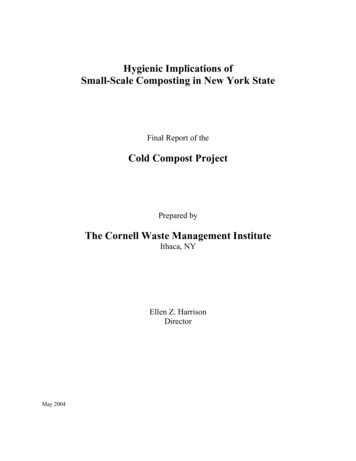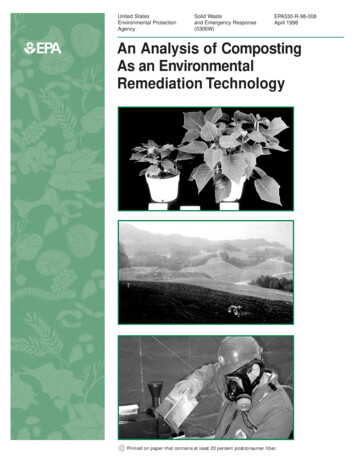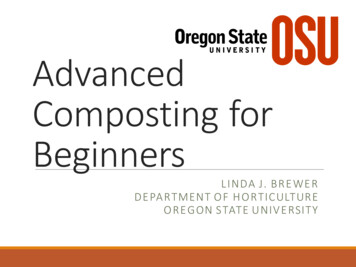
Transcription
AdvancedComposting forBeginnersL INDA J. BRE WE RDE PA R TMENT O F H O R TICULTUR EO RE G ON S TATE UNIV E RSITY
Why Compost?Manage yarddebrisManage domesticwasteGenerate soilconditioner
Organic Matter ImprovesSoil Quality and Soil HealthSoil moistureNutrient cyclingNutrient holdingcapacityCarbon sequestrationErosion reduction
Successful CompostingBlend thematerialsManage to suityour styleRecognize whenit’s finished
Compost: A Three-legged StoolC:Nairwater
AIR: WhyManage odor,heat, moisture,biology
AIR: HowPorosity:heterogeneoustextureTurning
edlowlowbadmoreslowerO2CO2anaerobicCH3HS
Water: Why . . .VersusWater that stays in place. . . and How
WATER: Too wet
WATER: Too dry
WATER: Just right
Compost Moisture Squeeze Test#1 reason for failure: not enough water.Squeeze a handful, hard – check for drips, look atyour hand.Too dry 40%Does notfeel moistJust right50-55%55-60%Too wet60-65%1-2 dropsSheen ongloved handCourtesy Compost Design Services 65%Stream ofwaterMany drops
C:N RATIO: WhyCarbon to Nitrogen RatioFAPA20C: NEfficientcompostingOdor controlBalanced diet formicrobes2416128020 40 60 80 100 120 140Composting time (days)
C:N RATIO: HowGreen stuff and brown stuffWho’s doing the composting?Temperature, composting speedFinal compost nutrient value
What is Green Stuff?Nitrogen sources: proteinFresh green plant materialsManures; meat; bone-,blood-, hoof-mealBagged fertilizerAlfalfa pelletsWater that stays in place
What is Brown Stuff?Carbohydrates: energyAbsorbencyDried brown plant materialsPaper, cardboardWood working hobbyistsPhoto Credit: Best of OSU Archives
Basic Compost RecipeOne part green stuffFour parts brown stuffAir and water as desired
Speed Survey:WHAT IS THE RIGHT WAYTO COMPOST?
We’re All RightAerobic compostingAnaerobic compostingSheet compostingDirect soil incorporation
Some are More Right than OthersEffort, time, personal preferenceWeeds, insects, disease problemsSpeed, spaceNuisance valueCompost quality
and now a word aboutTumblers
Methane DigestionLow work disposalConverts solids to GreenConeCO2, CH4 and waterMay produce planttoxic by-productstemporarilyAnd manyDIY ideas onYouTubeGedyeDoggieDooleyDoggieDoo Drain
Turning Compost
Lift composter from the compost.Begin forking the compost into the composter.
Layer in food waste and other freshmaterials as you move compost.
Use the fork to break up clumps as you go.
Alfalfa pellets - a good source of N.
Important PointsYour composting must fit your lifestyle.Tool choice is personal.Compost method choice is personal.
Pop Quiz: Compost MaturityWHEN IS COMPOST FINISHED?
When you say it isIntended use?Very immaturecomposts – toxic planteffectsVery mature composts– soil biology
Special Topics
Pop Quiz: Food WasteWHAT KINDS OF FOOD SCRAPSCAN BE COMPOSTED?
If you can eat it, you can compost it.
Safe Food Waste Composting.Never put in direct contact with soilNever have food as top layerLayer in absorbent carbon sourcesCompost aerobically in hot, active pileTurn the whole pile when you add food wasteTurn frequently
Wood AshSoluble K and PReadily availableRaises soil pHNot for acid-lovers5-10 pounds per 100square feet per year –no more!Annual soil testing
Pet Waste
Pet WastePathogen sourceConsult your haulerBury or process inmethane digesterNEVER put in contactwith edible plants orgarden soil
Manure as a Soil Amendment
NO!Predator speciesYes!Prey species
Common Manures: Hot to ColdHot & cold refer to ammonia risk.PoultryRabbitSheepGoatLlamaBeefHOTTERBut Also: Feed Storage AgeDairyHorse
Manure in the Home LandscapeApply during the growing season orApply in late summer with a cover crop.Don’t apply in the autumn or early spring.Which part of the crop do you eat?Never use raw hog manure; dog, cat, orhuman waste.
SodPhoto Credit: D Putnam, UC Davis
Keep your compost pile covered during therainy season
And duringthe dry season.
Linda J. BrewerD E P A R TM E N T O F H O R T I C ULT UR EO R E G O N S TA TE U N I V ER S I TYC OR VA LLIS, ORL I N D A . BR E W ER @ O RE G O NS TAT E. E D U
Success withVermicompostingL INDA J. BR E WE RDE PA RTMENT O F H O RTICULTUREO RE G ON S TATE UNIV E RSITY
First Read the BOOKWorms Eat My Garbageby Mary AppelhofMany editions and revisionsWormwoman.com
CaveatWorm composting generates moldspores.Red wigglers cannot be raised forrelease into garden soil.
VermicompostingSelect containerSelect beddingLocate red wigglersAssemble worm binAdd food and manage
Select Container
Select BeddingCommercial mixShredded paperNewsprintLeaf moldManure
Locate Red Wigglers
Assemble Worm Bin
Add Food and ManageMonitor moisture levelsMonitor odorMonitor egg layingMonitor other insectshormone stimulus
Manage the Bedding
Linda J. BrewerD E P A R TM E N T O F H O R T I C ULT UR EO R E G O N S TA TE U N I V ER S I TYC OR VA LLIS, ORL I N D A . BR E W ER @ O RE G O NS TAT E. E D U
Composting time (days) 0 20 40 60 80 100 120 140 N 8 12 16 20 24 FA PA Carbon to Nitrogen Ratio C:N RATIO: Why Efficient composting Odor control Balanced diet for microbes. C:N RATIO: How Green stuff and brown stuff Who's doing the composting? Temperature, composting speed Final compost nutrient value.
